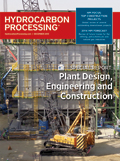
December 2013
Special Report: Plant Design, Engineering and Construction
Pressure relief analysis is a critical task at the engineering design stage of a grassroots oil refinery project. Relief loads must be determined so that the process units and plant flare systems can be designed.
Better materials can provide optimal equipment service life, reduce maintenance, mitigate contamination by corrosion products and minimize heat loss due to fouling.
Thanks to advances in gaming technology with detailed 3D modeling, it has become practical, affordable and quick to create a navigable, hyper-real equivalent of a facility.
Emergency depressurization is one of the most important design provisions for safeguarding facilities in case of an emergency. To overcome limitations of flare system capacity during such a scenario, depressurization can be practiced in a sequential manner. Presented here are the criteria and calculation methods for designing sequential depressurization, along with guidelines for the implementation of recommended designs.
HPI Focus: Top HPI Projects
Construction of HPI projects involves numerous risks for several parties. The design and construction of such complexes can take years, from project announcement to commissioning of the complexes. The..
Refining Developments
CASE STUDYThe basis for this case study is shown in Fig. 18; it is a crude unit with overhead heat integration. This is a one-drum overhead system with heat integration and no water wash. In an attemp..
Safety
In designing process safety systems, “more” is not necessarily better. Advanced technology has created a mindset to over-install hardware to prevent or to reduce the risk of failure in hydro..
Safety/Loss Prevention
Avoiding incident (or accident) recurrences at industrial systems is a long-standing problem, and it involves process safety strategies (PSSs). Incurring zero incidents is the ultimate goal for any st..
Columns
At times, engineers, bankers, scientists and accountants can be obsessed with numbers. Why? Because numbers are vital, especially in the design and operation of process units and equipment. Anniversar..
In 2009, an automation journal commissioned an online survey asking industry observers and practitioners to rank technology trends in 2009 and beyond.1 Table 1 summarizes the respondents’ prefere..
According to a new market study on engineering design tools, new 3D design applications can play an integral part in determining the optimal design, creation and construction of HPI facilities.
Much of Iraq’s future prosperity hinges on the success of its oil and gas sector. Petroleum already accounts for over 90% of the country’s energy needs, with a small percentage being supplie..
Analyzing failed parts or poor operation requires the proper skills and equipment. Sometimes these investigations are not always very difficult. Often, troubleshooting a failure just requires a logica..
Trends and Resources
After a bitter labor battle, INEOS Grangemouth reopensINEOS Grangemouth (UK) has reopened its petrochemicals plant and oil refinery in Scotland. The reopening comes after negotiations with the employe..
North American petrochemical producers have had lofty margins in recent years, given ample ethane feedstocks derived from the regional shale boom.Those margins, in turn, are leading to plans for new c..
Oil, natural gas and coal accounted for 87% of global primary energy consumption in 2012, according to a new Worldwatch Institute study. The relative weight of these energy sources keeps shifting, alt..
A bipartisan group called the US Energy Security Council, comprising former military, business and political leaders, has issued policy recommendations for the US Congress as it grapples with fuel-rel..
Research published by the Emissions Database for Global Atmospheric Research (EDGAR) indicates that global carbon dioxide (CO2) emissions increased by only 1.1% in 2012, yielding a slowdown in annual ..
This summary provides a "sneak peek" at Hydrocarbon Processing's HPI Market Data 2014. This comprehensive report investigates present and projected future trends in refining, natural gas and petrochemical industries. Topics include spending forecasts and construction projects derived from HP's Construction Boxscore database; global and regional changes in energy production and use; and developments in oil and natural gas processing. HPI Market Data 2014 also covers trends in economics, plant safety and the environment. This annual report is the hydrocarbon processing industry's premier source of market information for professionals working in the downstream.
Software combines crude management with designInvensys released its integrated Spiral CrudeSuite crude oil knowledge-management software (Fig. 1) with its SimSci PRO/II design and ROMeo optimization s..
Innovative flow/level measurement and application solutions Fluid Components International (FCI) provides a wide range of innovative instrument solutions that are said to lower operating costs, i..
Humidity calibrator provides 12 hours of battery-powered use The upgraded S503 portable humidity calibrator includes an optional battery pack for conducting calibrations at sites without electric..

- ITT to acquire SPX Flow for > $4.77 B, expanding leadership in highly engineered components and adjacent flow technologies 12/5
- MOL Group introduces eco-friendly Bag-in-Box packaging for lubricants 12/5
- Honeywell to supply integrated automation systems for flagship UK carbon capture projects 12/4
- Aduro Clean Technologies collaborates with ECOCE to advance plastics recycling in Mexico 12/4
- FincoEnergies launches GoodFuels B15: A reliable and compliant drop-in biofuel for inland shipping 12/4
- DevvStream, Southern Energy Renewables target low-cost, carbon-negative SAF and green methanol 12/4




